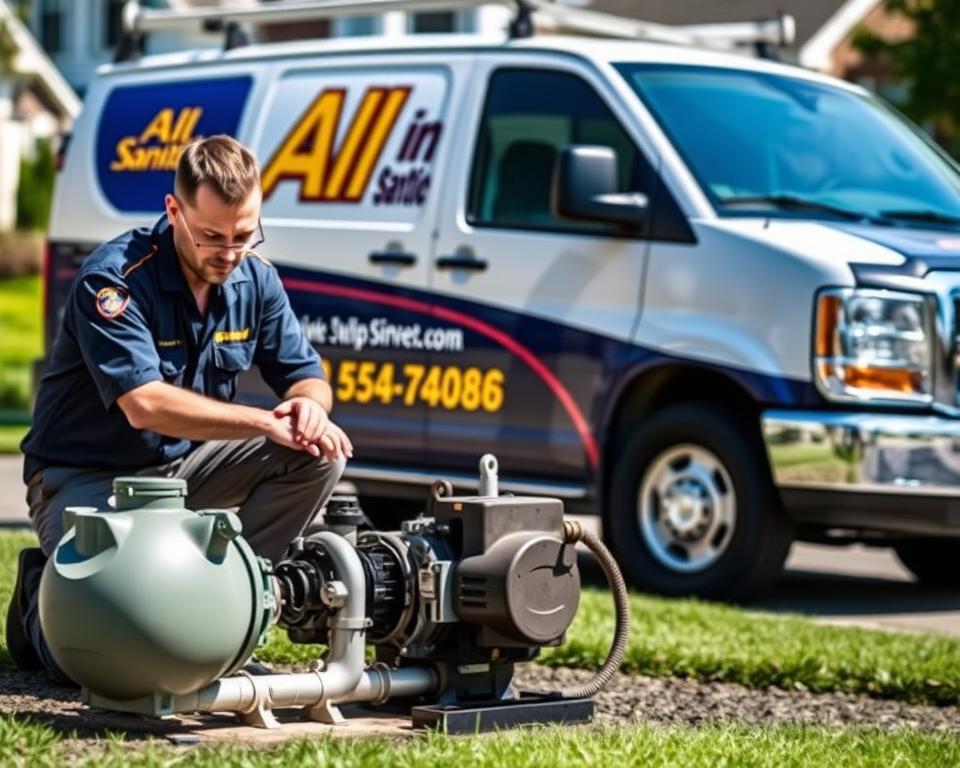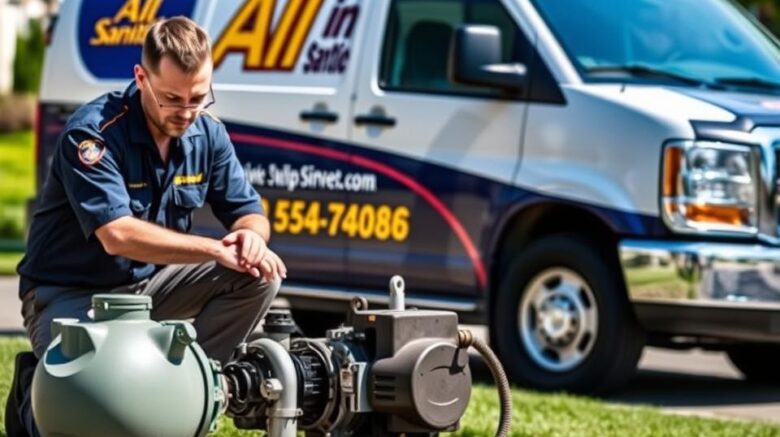Aerobic Tank Air Pump: Complete Guide for Residential Users
Have you ever wondered what boosts your aerobic Septic setup’s output? The air unit in your Septic system is the unrecognized hero crucial for your system. With this resource, homeowners will acquire valuable knowledge on the air Pump’s function. It’s critical for a healthy, optimized Septic tank.
Grasping the importance of a Septic tank air Pump can optimize your Septic system’s functionality using septic service. It also protects your real-estate worth and surrounding ecosystem. The following guide will introduce All in Sanitation, a reputable Septic industry expert. They’re prepared to handle your Septic aerator Pump requirements.
Noteworthy Points
- The Septic air Pump is crucial for aerobic Septic systems.
- Maintaining your Septic system air Pump can boost overall system function.
- Routine inspections lengthen the lifespan of your Septic tank air Pump.
- Picking the correct Septic aerator Pump is key for optimal operation.
- All in Sanitation offers dedicated services for Septic air Pump requirements.
Getting to Know Aerobic Septic Setups
Aerobic Septic systems deliver a higher-efficiency waste treatment option by supplying oxygen. This process consists of aerobic bacteria thriving in well-oxygenated environments. These bacteria are highly effective in processing organic matter. With the help of Septic aerator Pumps, these systems maintain a constant oxygen supply, boosting the waste decomposition process.
These systems shine in lowering sludge buildup, thanks to the efficiency of aerobic bacteria. This reduction in solid waste means reduced upkeep and tank emptying is required less often. Additionally, they reliably process wastewater, producing reduced odors. This creates a improved environment for homeowners and the community as a whole.
To make sure these systems work properly, it’s necessary to know the key Septic system components. These include the Septic tank, treatment chamber, and effluent Pump. Each part is vital, especially the air Pump. It drives oxygen into the tank, vital for the aerobic bacteria’s efficiency.
Importance of the Septic Air Pump
The Septic air Pump is pivotal in the running of aerobic Septic systems. It acts as the system’s “air provider,” pushing the vital oxygen essential. This oxygen allows aerobic bacteria to thrive and digest waste properly. If the Pump stops, the system’s efficiency drops, resulting in sludge accumulation and possible odors.
Such issues can disrupt Septic system operations and cause environmental hazards. By realizing how critical the Septic air Pump is, homeowners can respond ahead of time. They can ensure its peak function through regular maintenance. This avoids failures, reduces costly repairs, and maintains the aerobic system’s health.
Top Advantages of Using a Septic Air Pump
Utilizing a Septic air Pump greatly improves the efficiency of Septic systems. Septic air Pumps are crucial as they speed up the processing of waste. This is achieved by oxygenating the treatment process, encouraging aerobic bacteria growth. These bacteria are necessary for efficient waste treatment.
They’re also useful in lowering foul smells. Due to more active aerobic processes, waste decomposes faster, thus cutting down odors. This makes the environment more pleasant for homeowners.
Another noteworthy benefit is the drop in sludge accumulation. Consequently, tanks necessitate less frequent Pumping, cutting both money and time. Better processing not only reduces spending but also lengthens the lifespan of the drain field.
Looking after these Pumps correctly means minimal repair costs and meeting regulatory standards. Thus, the upsides of Septic air Pumps are not only for homeowners. They also contribute to environmental health by optimizing waste management practices.
| Benefit | Description |
|---|---|
| Fast Waste Breakdown | Greater aerobic activity quickens the decomposition process. |
| Minimized Odor Emissions | Superior treatment efficacy results in fewer odors. |
| Reduced Sludge Buildup | Less frequent Pumping and maintenance are necessary. |
| Extended Drain Field Life | Better treatment equals a healthier drain field. |
| Cost Savings | Lower likelihood of repairs and regulatory compliance cost. |

Choosing the Right Septic Air Pump
Picking the proper Septic air Pump is vital for an optimized aerobic system. Homeowners must consider various factors for the best fit. The volume of the tank and the airflow requirements play a crucial role the Pump’s efficiency.
To select well, it’s essential to be aware of the air Pumps available. There are mainly two types: diaphragm Pumps and rotary vane Pumps. Each offers particular pluses, which should be paired with your home’s individual circumstances and usage pattern.
Electric efficiency also deserves attention. Picking a Pump that cuts energy use while delivering the needed airflow can result in significant savings. Assistance from All in Sanitation professionals can be invaluable. They verify the Pump you choose fits your system’s requirements exactly.
Typical Classes of Septic Air Pumps
Homeowners can make better choices by being aware of the multiple Septic air Pumps available. There are mainly two types: diaphragm Pumps and rotary vane Pumps. Each has its specific functions and benefits.
Diaphragm Pumps, noted for their hushed operation, are favored for residential Septic systems. They maintain energy efficiency while supplying consistent airflow. Their reliable performance suits smaller systems, meeting the needs of many homeowners.
Rotary vane Pumps, however, are designed for higher-capacity or commercial systems. These Pumps provide increased power, essential in handling bigger loads. Their strong build guarantees efficient operation in broad Septic systems.
| Type of Pump | Best Use | Advantages |
|---|---|---|
| Diaphragm Pumps | Residential Systems | Quiet operation, energy-efficient, reliable air flow |
| Rotary Vane Pumps | Larger or Commercial Systems | Powerful performance, high capacity, durable construction |
Appreciating the variations in Septic air Pumps is essential for upgrades or replacements. Each Pump type offers unique qualities to address various needs. This ensures top performance for any system.
Signs You Might Need a Septic Air Pump Replacement
Homeowners must look out for Pump failure signs in their Septic systems. Some clues indicate the need for a Septic air Pump replacement. These help maintain smooth operation. Noticing these promptly sidesteps major issues.
Signs of potential problems include:
- Unusual noises from the Pump, like clanking or shaking, might show internal damage.
- A clear lack of air output means the Pump isn’t functioning properly, affecting efficiency.
- Regular electrical problems, such as circuit trips or lights dimming, could point to overloading.
- Visible damage on the Pump unit, with breaks or leaks, calls for quick action.
- Bad smells in the yard often suggest a compromised Pump, meaning ineffective effluent aeration.
Detecting these signs early avoids high repair bills or total system failure. Scheduling routine inspections makes it easy to catch these issues. It also shows if you ought to have a new Septic air Pump.
Maintenance Tips for Your Septic Air Pump
For an optimal Septic air Pump, routine upkeep is crucial. This guarantees that your system operates correctly. Homeowners can follow several practical care strategies for optimal results.
Twice a year, conduct a detailed inspection for wear or damage. It is also important to replace the filters as recommended. This prevents clogs that could hurt efficiency.
The Pump should be placed on a firm base to cut vibrations, which could damage it over time. A protective cover is important too. It shields against debris and water, maintaining the Pump’s functionality.
Diligent care can significantly prolong the life of your Pump. In turn, this benefits the Septic system’s performance collectively.
| Maintenance Task | Frequency | Benefits |
|---|---|---|
| Inspect Pump for damage | Every 6 months | Identifies issues early |
| Replace filters | As needed | Improves efficiency |
| Check surface stability | Annually | Limits wear |
| Clear debris around Pump | Monthly | Maintains airflow |
Fitting Your Septic Air Pump
Accurate installation of your Septic air Pump is essential for its smooth operation. To start, select a reliable, moisture-free area for placement. The chosen spot should safely accommodate the Pump’s weight with ease.
To successfully mount your Pump on your own, use the following guidelines:
- Assemble all necessary items, including the Pump, a power source, and hose fittings.
- Thoroughly review the manufacturer’s guidelines before beginning your installation.
- Make sure every connection is secure to eliminate air leaks that hurt performance.
- After assembly, complete a test to check the system works as intended.
If the installation process seems daunting, contact All in Sanitation. Their professionals can avoid common errors, guaranteeing your setup follows necessary safety requirements.
Benefits of Choosing All in Sanitation for Your Septic Air Pump Needs
When deciding on a Septic service provider, the choice is key. All in Sanitation distinguishes itself by supplying dependable Septic air Pumps. They address varied homeowner requirements with a comprehensive selection of top-tier products. This guarantees customers find an ideal match for their Septic systems.
What truly separates All in Sanitation is more than their large product lineup. Their devotion to exceptional customer service is also critical. Homeowners receive expert advice, helping them choose trusted Septic solutions. This teamwork is essential to personalize each solution to satisfy specific needs.
All in Sanitation also prioritizes aftercare to ensure lasting satisfaction. Their promise reaches beyond the initial sale. They deliver ongoing support to keep Septic systems running smoothly for the long term.
Budget Factors for Septic Air Pumps
Grasping the financial elements linked to Septic air Pumps is key for homeowners using aerobic Septic systems. Up front, one faces the purchase price, which includes the Pump and associated accessories. Installation expenses fluctuate, according to the system’s complexity and any changes required.
Ongoing upkeep forms an additional cost layer. Periodic reviews can head off bigger issues, ultimately leading to savings. Homeowners should set aside funds for Septic maintenance to keep the Pump’s effectiveness and life expectancy. Such planning helps dodge expensive repairs later on, illustrating the value of proactive maintenance.
| Cost Component | Average Cost Range |
|---|---|
| Septic Air Pump | $500 – $1,200 |
| Installation | $300 – $800 |
| Annual Maintenance | $150 – $400 |
| Potential Repair Costs | $1,000 – $5,000 |
Dividing Septic air Pump expenses into separate parts helps homeowners in budgeting. This detailed approach secures the system’s consistent operation and their peace of mind.
To Conclude
For homeowners with aerobic Septic systems, caring for Septic units is crucial. The suitable Septic air Pump boosts waste processing and increases your system’s life. Scheduling consistent service and swiftly handling issues prevents expensive repairs and disruptions.
Choosing a Septic air Pump warrants careful thought. This guide outlined how to make smart choices about installation and replacement. With All in Sanitation’s support, you can handle your Septic systems’ complexities with confidence.
Attending to your Septic air Pump enhances your system’s functionality and service life. It guarantees a reliable and effective operation over time. Bear in mind, your home’s wastewater management is greatly improved by proper care.
